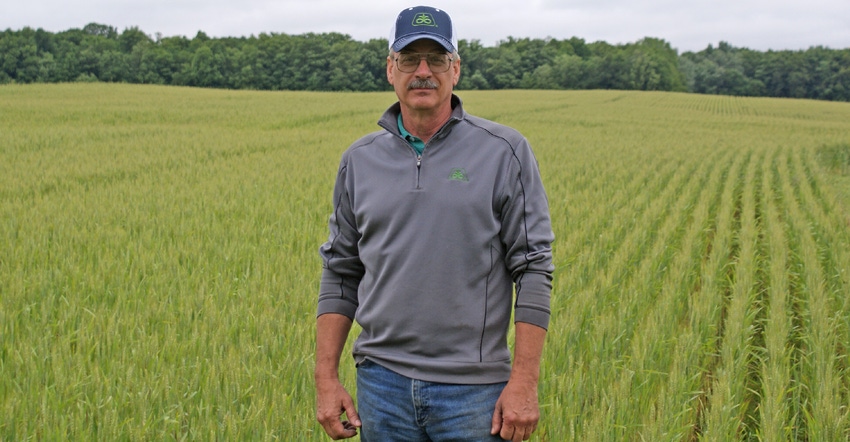
It really makes a statement when the worst ground Don Stall farms produces the nation’s highest-yielding corn.
Stall, of Charlotte, was the only Michigan national winner in the National Corn Growers Association yield contest, but he did it in a big way — harvesting 476.91 bushels per acre, taking the top rank in the conventional irrigated ground category and the highest yield in the country.
Stall is a sixth-generation farmer. He and his 88-year-old father, Doug, farm 3,100 acres of mostly corn and soybeans with a couple hundred acres of wheat.
The winning yield was with Pioneer hybrid P0720AM.
“This particular ground can’t hold water; that's why it has a center pivot on it,” Stall says, while noting he has mostly capac soils.
Getting that soil to produce requires intensive management. “It’s connecting a bunch of different practices and strategies,” Stall says. “There’s not one thing that gets you there, but rather a bunch of little things.”
It’s a recipe he’s been perfecting. He’s been entering the contest since 2003, and in recent years has become a familiar name. This is the second time he’s been the national top-yielding producer, bringing in 477.6 bushels per acre in 2018 on conventional irrigated ground.
“I never thought it would be possible to win the top national award, let alone two times,” Stall says. He’s also placed in categories, taking first place in the 2017 national conventional irrigated competition with 407.2 bushels per acre and third place in 2019 in the conventional dryland contest with 356.2 bushels per acre.
“Winning is great, but it's not everything; you can't take it too seriously,” he says. “But it's an honor to get acknowledgment from your peers.”
The next highest yield in the 2020 contest was Daniel Gause Sr., who landed a 387.09-bushels-per-acre entry in the no-till, nonirrigated corn category on his Scranton, S.C., farm with Pioneer hybrid P1847VYHR.
Close behind him, for the third-highest yield, was Kevin Kalb, of Dubois, Ind., with a 385.44-bushels-per-acre entry in the conventional, nonirrigated category with DeKalb hybrid DKC67-44RIB.
The recipe
Stall's seed sales representative is his cousin, Roy Simpson, who works with his son, Grant. “They have always done well for getting the right product on our acres,” Stall says. “We leave a lot of that decision up to them to give us a couple options, and we go forth from there. We also do trials on our farm to get an idea of how it’s going to work for us, and we’re cooperators with Pioneer, so we get that data as well.”
Once the soybeans were off in fall 2019, Stall applied variable-rate fertilizer based on 1-acre grid soil samples conducted every year. “The remarkable thing is, it doesn't call for hardly any fertilizer and hasn't for years,” he adds.
Michigan had a cold, wet spring. Seeds were planted at 48,500 plants per acre May 4, but with cold ground, they took three weeks to emerge. Even with a torrential May 15 rain, Stall ended up harvesting 46,500 plants per acre. “We didn’t lose too much, and that's probably due to the good fertility,” he adds.
Stall did four split applications, starting with a coulter cart at V3, applying 50 gallons of 28% nitrogen plus ammonium thiolsulfate to keep the nitrogen-to-sulfur ratio at 10 to 1. “The ratios are right where we want them, and we apply to maintain,” he says.
He fed the crop again at V7 with 20 gallons of 28% nitrogen and boron using a RoGator. That same application was repeated at V9 and V12 with 50 gallons.
“We do a lot of feeding of the microbes; we use some biological products,” Stall explains. “We do a lot of tissue testing to validate our program, and that’s helping. We also used evapotranspiration sensors this year for the first time to get an idea of how much water the crop was using to help with irrigation.”
He credits some of his success to his soil fertility ratios. “Our ratios have allowed us to buffer from some of the drought and the wet stresses that we run into during the year.”
Stall had no disease issues until after Labor Day, when tar spot came on. However, he had sprayed Approach Prima fungicide at half-brown silk as a preventative. “That's something we always do on irrigated acres because we are keeping the crop in an environment susceptible to leaf diseases especially,” he says.
What’s ahead for 2021? Stall says, “We're discussing population — it’s always a big consideration. On this hybrid, I don't know whether to go up or down. It was pollinated all the way to the tips, so normally that tells us we need to plant thicker next year.
"But we're kind of afraid that with more of a flex-ear hybrid like P0720 AM, we may actually go backward. We’re also looking to add more carbon products to try to free up more calcium to the plant. Other than that, we're just going to stick with what we know works, and hopefully the weather will cooperate.”
About the Author(s)
You May Also Like






